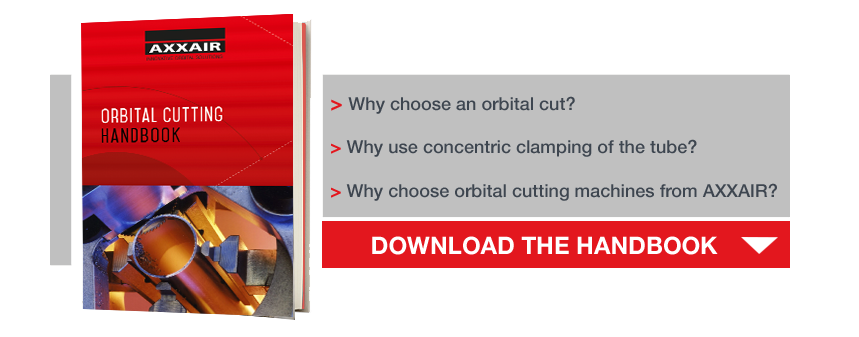In the food processing or pharmaceutical industry the use of < 3 mm wall stainless steel tube has an essential aspect: the orbital cutting. In order to do this, you have to take into account the relative fragility of these thin tube which need a meticulous care, for stability and fixation when you clamp them.
Why choose a concentric clamping instead of using a vice?
Orbital cutting can be distinguished in a very simple way :
- no constriction of the tube
- the recovery of the possible ovality of these very thin tubing
The most important elements are the jaws. When you handle thin tube with a vice, the resulting imperfection can be compared with poor quality manual work. The constriction of the tube is often unavoidable with 2 V at each end.
On the other hand, when you use a concentric clamping, you use 4 clamping jaws placed at 4 times 90° of the tube.
In this way, these 4 points clamp the tube in a harmonious way and avoid any constriction of the tube.
Which are the disadvantages of a bad clamping using a vice?
The human hand, that can be clumsy, sometimes brutalizes the material. The direct consequence is a mismatch between the tube when it comes to weld them.
The use of a vice causes a distortion of the tube which is not accepted in several industries, such as the food processing where thin stainless steel tube are widely used with a maximum thickness of 3 mm. For this kind of application, only the concentric clamping can be used.
The four jaws are perfectly positioned around the cylindrical tube and the output force is guided by a wheel with accuracy and precision. On the other hand, if you use a vice, the tube can be damaged and have to be scrapped.
What are the main qualities of a concentric clamping compared to the use of a vice?
A concentric clamping is important as it has a direct influence on the orbital cutting and finally the welding. Concentric clamping needs a fixing point for the cutting tool, which rotates around the tube at 360°. In order to avoid any movement of the tube, the concentric clamping maintains the tube on all its surface with the four jaws covering the total surface of the tube. Afterwards the cutting operation will proceed in a harmonious way, with precision and without distortion, collusion, crap or burr.If you wish to avoid having useless distorted tube after having cut the tube with a vice, which will cause a lower production rate, just contact a company who has a perfect knowledge and expertise in orbital cutting systems equipped with jaws that are all identical. Only the number of jaws vary according to the diameter of the tube.
When you use equipment able to handle an large diameters, you will need more jaws in order to clamp the tube in a strong and precise way. The CC81 is equipped with 3 jaws whereas the CC1100 has 16 jaws.
In total you can have about ten concentrically clamping systems for all different sizes of tube.
Find out more about orbital cutting by downloading our free ebook!



